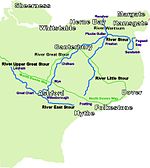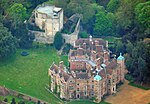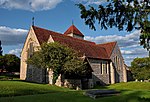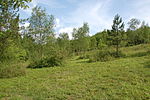Julliberrie's Grave, also known as The Giant's Grave or The Grave, is an unchambered long barrow located near to the village of Chilham in the south-eastern English county of Kent. Probably constructed in the fourth millennium BCE, during Britain's Early Neolithic period, today it survives only in a state of ruin.
Archaeologists have established that the monument was built by pastoralist communities shortly after the introduction of agriculture to Britain from continental Europe. Although representing part of an architectural tradition of long barrow building that was widespread across Neolithic Europe, Julliberrie's Grave belongs to a localised regional variant of barrows produced in the vicinity of the River Stour. Of these, it lies on the eastern side of the river, alongside the Shrub's Wood Long Barrow, while the third known example in this barrow group, Jacket's Field Long Barrow, is located on the western side.
Julliberrie's Grave is 44 metres (144 ft) long, 2 metres (6 ft 7 in) high, and 15 metres (49 ft) at its widest. It was originally larger, with the northern end having been destroyed. Unlike many other long barrows, no evidence for any Early Neolithic human remains have been found at the site; it is possible that its builders never placed human remains within it, or that such burials were included in the barrow's (since lost) northern end. A broken polished stone axe was included in the centre of the monument, which archaeologists believe was likely placed there as part of a ritual act of deposition. A rectangular pit was dug into the western side of the barrow shortly after its completion, likely containing a ritual deposit of organic material, before being refilled.
In the Iron Age, a hearth was established in the ditch circling the barrow; in the Romano-British period, human remains and a coin hoard were buried around its perimeter. Ensuing millennia witnessed local folklore grow up around the site, associating it with the burial of either a giant or an army and their horses. The ruin attracted the interest of antiquarians in the 17th century, although was heavily damaged by chalk quarrying around the 18th. During the 18th and 19th century, antiquarians dug into the barrow at least twice, while cautious archaeological excavation took place in the 1930s. A Scheduled Ancient Monument, it is accessible to visitors all year around.












